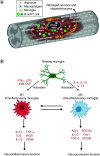Therapeutic targets and nanomaterial-based therapies for mitigation of secondary injury after spinal cord injury
- PMID: 34402308
- PMCID: PMC8411395
- DOI: 10.2217/nnm-2021-0113
Therapeutic targets and nanomaterial-based therapies for mitigation of secondary injury after spinal cord injury
Abstract
Spinal cord injury (SCI) and the resulting neurological trauma commonly result in complete or incomplete neurological dysfunction and there are few effective treatments for primary SCI. However, the following secondary SCI, including the changes of microvasculature, inflammatory response and oxidative stress around the injury site, may provide promising therapeutic targets. The advances of nanomaterials hold promise for delivering therapeutics to alleviate secondary SCI and promote functional recovery. In this review, we highlight recent achievements of nanomaterial-based therapy, specifically targeting blood-spinal cord barrier disruption, mitigation of the inflammatory response and lightening of oxidative stress after spinal cord injury.
Keywords: biomaterials; blood–spinal cord barrier; drug delivery; inflammation; nanotechnology; oxidative stress; secondary injury; spinal cord injury.
Conflict of interest statement
This research was partly supported by the National Institute of Neurological Disorders and Strokes (NINDS) of the NIH under grant number 5R01 NS111037-02. This research was also partly supported by the National Institute of General Medical Sciences (NIGMS) of the NIH under award number 5P20GM103444-07 and the South Carolina Bioengineering Center of Regeneration and Formation of Tissues (SCBioCRAFT). The authors have no other relevant affiliations or financial involvement with any organization or entity with a financial interest in or financial conflict with the subject matter or materials discussed in the manuscript apart from those disclosed.
No writing assistance was utilized in the production of this manuscript.
Figures




Similar articles
-
Recent advances in nanotherapeutic strategies for spinal cord injury repair.Adv Drug Deliv Rev. 2019 Aug;148:38-59. doi: 10.1016/j.addr.2018.12.011. Epub 2018 Dec 22. Adv Drug Deliv Rev. 2019. PMID: 30582938 Free PMC article. Review.
-
Biodegradable bilayer hydrogel membranes loaded with bazedoxifene attenuate blood-spinal cord barrier disruption via the NF-κB pathway after acute spinal cord injury.Acta Biomater. 2023 Mar 15;159:140-155. doi: 10.1016/j.actbio.2023.01.056. Epub 2023 Feb 1. Acta Biomater. 2023. PMID: 36736849
-
Protocatechuic acid improves functional recovery after spinal cord injury by attenuating blood-spinal cord barrier disruption and hemorrhage in rats.Neurochem Int. 2019 Mar;124:181-192. doi: 10.1016/j.neuint.2019.01.013. Epub 2019 Jan 18. Neurochem Int. 2019. PMID: 30664898
-
Tauroursodeoxycholic acid alleviates secondary injury in spinal cord injury mice by reducing oxidative stress, apoptosis, and inflammatory response.J Neuroinflammation. 2021 Sep 20;18(1):216. doi: 10.1186/s12974-021-02248-2. J Neuroinflammation. 2021. PMID: 34544428 Free PMC article.
-
Antioxidant nanozymes: current status and future perspectives in spinal cord injury treatments.Theranostics. 2025 May 8;15(13):6146-6183. doi: 10.7150/thno.114836. eCollection 2025. Theranostics. 2025. PMID: 40521206 Free PMC article. Review.
Cited by
-
Bibliometric analysis of nanotechnology in spinal cord injury: current status and emerging frontiers.Front Pharmacol. 2024 Dec 11;15:1473599. doi: 10.3389/fphar.2024.1473599. eCollection 2024. Front Pharmacol. 2024. PMID: 39723251 Free PMC article.
-
Biomaterials delivery strategies to repair spinal cord injury by modulating macrophage phenotypes.J Tissue Eng. 2022 Dec 26;13:20417314221143059. doi: 10.1177/20417314221143059. eCollection 2022 Jan-Dec. J Tissue Eng. 2022. PMID: 36600997 Free PMC article. Review.
-
Tanshinone-IIA mediated neuroprotection by modulating neuronal pathways.Naunyn Schmiedebergs Arch Pharmacol. 2023 Aug;396(8):1647-1667. doi: 10.1007/s00210-023-02476-8. Epub 2023 Apr 3. Naunyn Schmiedebergs Arch Pharmacol. 2023. PMID: 37010572 Review.
-
The immune microenvironment and tissue engineering strategies for spinal cord regeneration.Front Cell Neurosci. 2022 Aug 4;16:969002. doi: 10.3389/fncel.2022.969002. eCollection 2022. Front Cell Neurosci. 2022. PMID: 35990891 Free PMC article. Review.
-
Protective Effect of Hydrogen-Rich Saline on Spinal Cord Damage in Rats.Pharmaceuticals (Basel). 2023 Apr 1;16(4):527. doi: 10.3390/ph16040527. Pharmaceuticals (Basel). 2023. PMID: 37111284 Free PMC article.
References
-
- Mahabaleshwarkar R, Khanna R. National hospitalization burden associated with spinal cord injuries in the United States. Spinal Cord 52(2), 139–144 (2014). - PubMed
-
- Krueger H, Noonan VK, Trenaman LM, Joshi P, Rivers CS. The economic burden of traumatic spinal cord injury in Canada. Chronic Dis. Inj. Can. 33(3), 113–122 (2013). - PubMed
Publication types
MeSH terms
Grants and funding
LinkOut - more resources
Full Text Sources
Medical
